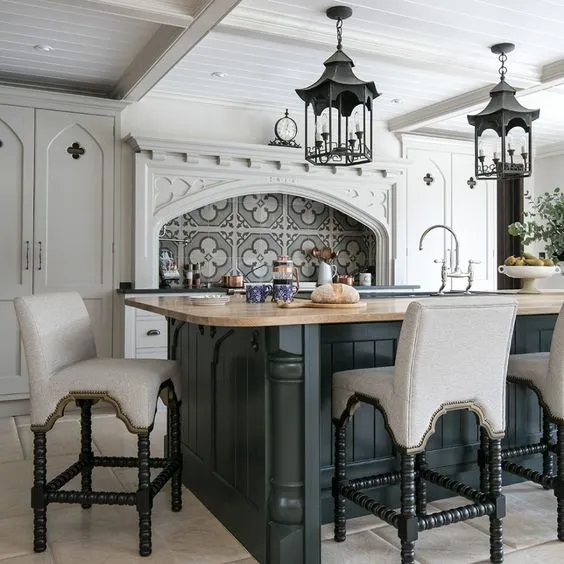Embracing the Gothic Kitchen Aesthetic
The allure of gothic kitchen decor stems from its rich history and dramatic aesthetic, creating a space that is both visually striking and deeply personal. This style draws heavily from the Gothic period of architecture and design, which flourished from the late medieval era. Characterized by pointed arches, intricate details, and a sense of grandeur, gothic kitchens offer a unique alternative to the more common kitchen styles. If you are looking to infuse your cooking space with an aura of mystery and sophistication, gothic kitchen decor provides a perfect canvas. It’s about more than just aesthetics; it’s about creating a space that tells a story and reflects a distinctive taste. The following guide will navigate you through the essential elements and creative ideas to transform your kitchen into a gothic sanctuary.
Historical Inspiration for Gothic Kitchens
To truly understand the essence of gothic kitchen decor, one must delve into its historical roots. The Gothic period, spanning roughly from the 12th to the 16th centuries, was a time of significant architectural and artistic advancements. Gothic cathedrals, with their soaring arches, stained glass windows, and ornate carvings, set the stage for the design principles that would later influence interior spaces. In the context of kitchens, this historical context provides valuable insights for selecting appropriate design elements and materials. Key features from the Gothic era that can be incorporated into modern kitchen designs include the use of dark, rich colors, the incorporation of stone and metal, and the strategic placement of decorative elements to create a sense of depth and drama. Understanding the historical background will help you make informed choices that align with the gothic aesthetic and maintain its authentic feel.
Gothic Architecture Influence
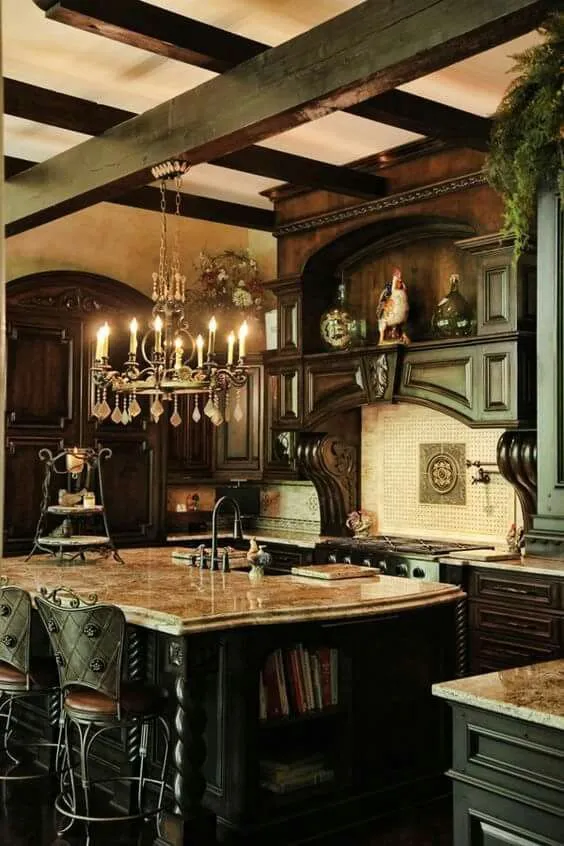
Gothic architecture, with its distinctive pointed arches, ribbed vaults, and flying buttresses, is a primary source of inspiration for gothic kitchen design. These architectural elements can be translated into kitchen design through the use of arched doorways, window frames, and even cabinet designs. The play of light and shadow, a significant aspect of Gothic architecture, can be achieved by incorporating strategically placed lighting fixtures that highlight the textures and details within the kitchen. Utilizing dark, textured materials and incorporating vertical lines can further emphasize the architectural influence. The overall goal is to create a space that evokes the grandeur and solemnity of gothic cathedrals, adapting the principles of architectural design to the functionality and aesthetics of a modern kitchen. Consider the use of faux stained-glass accents to add a touch of gothic charm, or incorporate ironwork details reminiscent of church gates and doors to enhance the atmosphere.
Key Elements of Gothic Design
Several key elements define the gothic design aesthetic, making it unique and easily identifiable. Dark, rich colors such as deep reds, purples, blacks, and forest greens form the foundational color palette, creating a sense of intimacy and mystery. Heavy, ornate detailing is another key feature, with the use of carved wood, wrought iron, and stone adding texture and visual interest. The strategic use of lighting is crucial, often involving chandeliers, sconces, and strategically placed lamps to create dramatic shadows and highlight architectural details. Incorporating stained glass adds a pop of color and historical richness. By understanding these elements, you can start to bring a gothic flair to your kitchen. Think about incorporating these details to make your kitchen space distinct and compelling.
Top 7 Gothic Kitchen Decor Ideas
Transforming your kitchen into a gothic haven involves incorporating specific design elements that capture the style’s essence. These ideas will help you get started, offering a mix of practical and aesthetic considerations. From selecting the right materials to incorporating gothic-inspired accents, these ideas provide a clear pathway to achieving the dramatic and elegant atmosphere of a gothic kitchen. Each of these ideas offers a unique approach to infusing the gothic aesthetic into your kitchen, ensuring a cohesive and visually captivating space. Whether you are starting a renovation or simply updating your decor, these elements will help you create a kitchen that truly reflects the style and spirit of the Gothic period.
Dark Cabinetry and Finishes
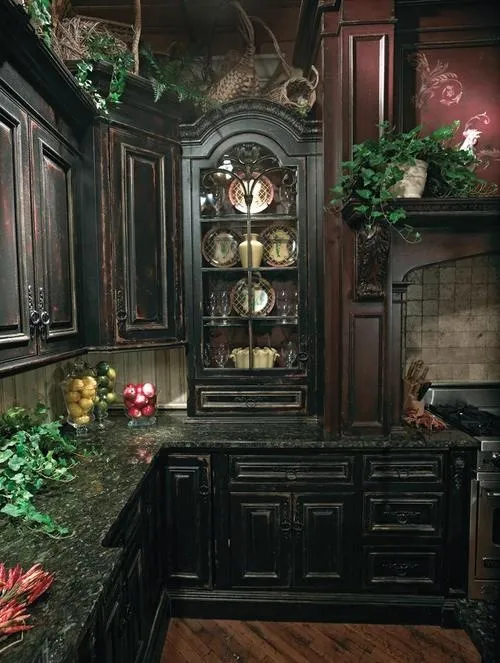
Dark cabinetry forms the foundation of a gothic kitchen, creating a dramatic and moody atmosphere. Consider using deep hues like ebony, charcoal gray, or even dark, rich wood stains. These colors provide a stark contrast to lighter countertops and accessories, enhancing the overall gothic aesthetic. The finish of your cabinets is equally important; matte or satin finishes are often preferred over glossy ones, as they provide a more subdued and elegant look. Wood grain should be visible, adding texture and character. The choice of cabinetry material can further enhance the gothic feel. Solid wood cabinets offer durability and a rich appearance, while options like painted MDF can provide a smooth finish that complements the darker color palette. Pair these cabinets with ornate hardware and you have the beginnings of a gothic kitchen design.
Selecting the Right Wood and Stain
When choosing wood and stain for your cabinetry, consider the type of wood that will best complement the gothic aesthetic. Dark woods like mahogany, walnut, or even cherry are excellent choices, as their inherent richness and deep tones align with the gothic style. These woods often have beautiful grain patterns that can be highlighted with the right stain. The stain color should be chosen carefully, as it will significantly impact the overall look of your kitchen. Dark stains like ebony, espresso, or dark walnut will enhance the gothic mood, creating depth and visual interest. Make sure to test the stain on a small piece of wood first to ensure you achieve the desired effect. Proper staining techniques are crucial to ensure a uniform finish. Apply multiple thin coats, allowing each coat to dry completely before applying the next. Protecting the cabinets with a clear topcoat can also extend their life and enhance the finish.
Incorporating Gothic Archways
Gothic archways are a quintessential feature of gothic architecture, offering a distinctive design element that can be seamlessly integrated into your kitchen. These arches, characterized by their pointed shape, add a touch of elegance and drama to your space. Consider incorporating arched doorways between your kitchen and other rooms or creating arched openings for your pantry or wine cellar. These architectural features instantly enhance the gothic character of your kitchen. If a full archway renovation isn’t feasible, you can mimic the effect by adding decorative trim or molding to existing doorways, creating a visual illusion of an arched opening. Another creative option is to incorporate arched elements into your cabinetry design. Customizing your cabinets with arched panels or doors can significantly elevate the gothic feel. The key is to subtly incorporate the arch shape to create a sense of visual harmony and elegance, tying the elements of your kitchen together.
Using Gothic-Style Hardware
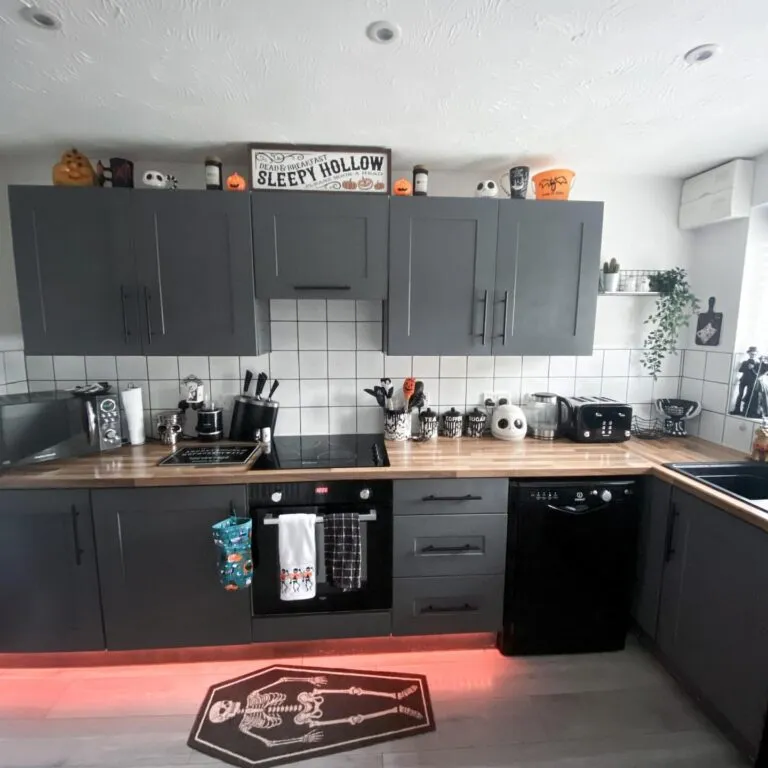
Gothic-style hardware, with its ornate designs and dark finishes, is a key element in enhancing the gothic aesthetic of your kitchen. The right hardware can transform standard cabinets and drawers into pieces that embody the style. Look for cabinet pulls, knobs, and hinges that feature intricate detailing, such as fleur-de-lis, crosses, or other Gothic-inspired motifs. Finishes like antique bronze, wrought iron, or even dark pewter are excellent choices. They provide a vintage, slightly aged look that perfectly complements the gothic style. Consider the size and shape of the hardware in relation to your cabinets. Larger, more elaborate pulls can make a statement on larger cabinets, while smaller, more delicate knobs are suitable for drawers and smaller doors. Changing your cabinet hardware is an easy and effective way to instantly upgrade the look of your kitchen. Shop at specialty hardware stores or online retailers to discover a wide selection of gothic-inspired hardware.
Choosing Decorative Lighting Fixtures
Lighting plays a pivotal role in establishing the ambiance of a gothic kitchen. Choosing the right lighting fixtures can emphasize the dramatic and mysterious atmosphere that defines this style. Chandeliers are an iconic choice, often featuring intricate designs, wrought iron detailing, and candle-like bulbs to create a soft, inviting glow. Sconces, placed on the walls, can further enhance the lighting scheme by adding layers of light and highlighting architectural details. Look for fixtures with dark, textured finishes or those with intricate glasswork. Pendants over kitchen islands or dining areas can also enhance the gothic aesthetic. Consider fixtures that feature dark metal finishes, decorative chains, or even elements like faux candles. Dimmer switches are essential, allowing you to adjust the light levels to match the mood. In addition to the aesthetic aspects, remember to incorporate task lighting where necessary, such as under-cabinet lighting, to ensure the kitchen is functional and well-lit for cooking and food preparation.
Adding Gothic-Inspired Accessories
Accessories are crucial in completing the gothic kitchen look, adding personality and flair to your space. Items like wrought iron candle holders, antique mirrors, and ornate serving dishes provide the perfect accents. Choose accessories that incorporate gothic motifs, such as crosses, gargoyles, or fleur-de-lis. Incorporating a variety of textures and materials, such as stone, metal, and velvet, can add depth and richness to the space. Place antique books on open shelves or countertops to evoke a sense of history and scholarship. A decorative wine rack made of wrought iron can be both functional and stylish, perfectly complementing the overall gothic vibe. Consider adding gothic-inspired artwork to your walls, such as dark landscapes or portraits. The key is to balance the accessories, avoiding clutter while adding personal touches that reflect the gothic style and your individual taste. Look for unique items at antique shops, flea markets, or online retailers specializing in gothic decor.
Textured Wall Treatments
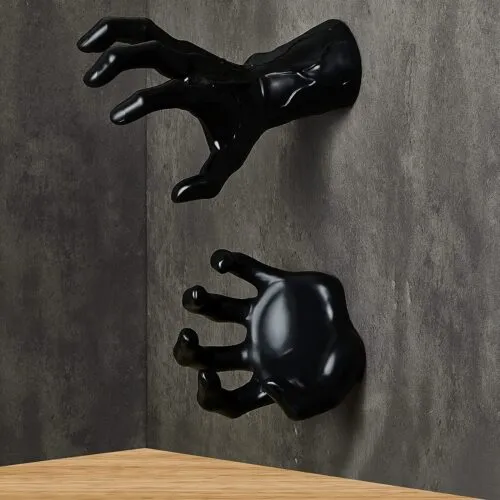
Textured wall treatments contribute significantly to creating the right gothic atmosphere in your kitchen. The choice of wall treatments can completely transform the space, adding depth and visual interest that is central to the gothic style. Consider using materials like exposed brick, which provides a rustic, timeless look. Faux stone panels can also be used to emulate the feel of a gothic castle or cathedral. For a more subtle approach, consider using textured paint. Techniques like faux painting or creating a distressed finish can add depth and enhance the visual appeal. Another option is to use wainscoting or paneling, which adds a classic touch and provides a visual frame for the room. Dark, rich colors can make your space feel more intimate. Remember to complement your wall treatments with the right lighting; this will emphasize the textures and shadows, enhancing the overall effect.
Incorporating Stone and Metal Elements
The use of stone and metal elements is fundamental in gothic kitchen decor, as these materials were prevalent during the Gothic period and add a touch of authenticity. Stone can be incorporated through countertops, backsplashes, or even flooring. Granite or slate countertops provide a durable and stylish surface, perfectly complementing the dark cabinetry and hardware. Backsplashes made of stone or tile with intricate patterns add visual interest. Metal accents, such as wrought iron or cast iron, can be used for various design elements. Consider a wrought iron pot rack, a metal range hood, or even decorative metal shelves. Metallic finishes, such as bronze or pewter, create a sense of depth and add a layer of sophistication. The integration of these materials will not only enhance the gothic aesthetic but also contribute to the kitchen’s sense of history and craftsmanship.
Where to Source Gothic Kitchen Decor
Finding the right gothic kitchen decor can feel like a treasure hunt. There are several avenues to explore, from specialized online retailers to local antique shops. By knowing where to look, you can find unique and inspiring elements to elevate your kitchen design. Understanding the options available will help you in your search. The internet offers an extensive range of gothic kitchen decor, and visiting physical stores can provide hands-on experiences.
Online Retailers and Specialty Shops
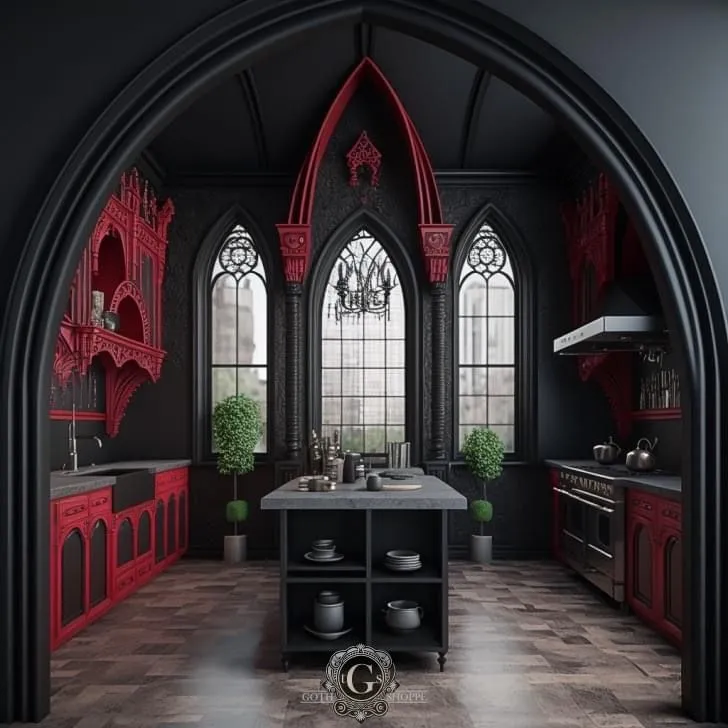
Online retailers provide the best opportunity to discover a wide array of gothic kitchen decor. Websites such as Etsy offer unique, handcrafted items and vintage finds, perfect for adding character to your kitchen. Specialty shops focused on gothic decor often stock a curated collection of furniture, accessories, and lighting fixtures. Look for retailers that specialize in antique or vintage items. These sources often carry original pieces that add historical value and authenticity to your space. When shopping online, read customer reviews carefully to ensure the quality of the items. Also, check the shipping and return policies before making a purchase. Local antique shops and flea markets are also valuable resources for finding unique pieces. These stores offer an opportunity to see items in person and discover one-of-a-kind treasures.
Tips for Budget-Friendly Gothic Decor
Creating a gothic kitchen doesn’t have to break the bank. By implementing smart strategies, you can achieve the desired look without overspending. Start by repurposing existing items. Consider refinishing your current cabinets with a dark stain or paint. This is a cost-effective way to instantly change the look of your kitchen. Shop at thrift stores, flea markets, and online marketplaces to find affordable accessories, such as candle holders, antique mirrors, and serving dishes. DIY projects can also save you money. Creating your own wall art or adding decorative touches can bring a personalized touch to your kitchen. Focus on key elements that define the gothic style and make a significant visual impact. Sometimes, just a few well-chosen pieces can make a big difference. Prioritize items that are both functional and decorative. By focusing on these strategies, you can bring a touch of gothic elegance to your kitchen without exceeding your budget.
In conclusion, designing a gothic kitchen provides a rewarding opportunity to create a space that is both beautiful and reflective of your personal style. The key lies in understanding the essential elements of gothic design, from dark cabinetry and ornate hardware to strategic lighting and carefully chosen accessories. By incorporating these elements thoughtfully, you can transform your kitchen into a dramatic and elegant space that embodies the spirit of the Gothic period. As you begin your project, remember that the most important factor is to infuse your personal touch and style.
